How To Install A Culvert In A Ditch


Temporary sediment trap with forebay, click image for more information (Source: Tetra Tech)
Sediment traps and basins are settling ponds formed past excavation and/or an embankment that intercept and retain sediment-laden runoff from a construction site for a sufficient period of time to allow the bulk of sediment to settle out prior to being released from the site. They may be synthetic equally smaller sediment traps – serving disturbed areas of less than 5 acres – or every bit larger sediment basins, handling mass grading runoff from subdivisions, commercial/institutional sites, or roadway projects. Proper utilise of these structures can greatly reduce sediment ship off-site; if properly designed, installed, and maintained, sediment removal efficiency of 80 percent or greater tin can be achieved, depending on soil particle size . Sediment traps are often temporary and usually decommissioned later the disturbed area is stabilized (i.e., with vegetation or other cover). Temporary sediment basins tin can be converted to permanent stormwater management basins subsequently structure is consummate. Sediment traps and basins are very useful on structure sites with moderate to steep slopes . The choice of traps versus basins primarily depends on the size of the contributing drainage area and plans for post-construction stormwater management, equally discussed beneath.
Contents
- 1 Purpose and function
- 2 Applicability
- 2.i Site applicability
- 2.2 Let applicability
- two.2.1 Specific permit linguistic communication
- 3 Effectiveness
- 4 Planning Considerations
- v Pattern
- five.ane Sediment traps
- 5.2 Sediment Basins
- 6 Structure recommendations and specifications
- vii Inspection and maintenance
- seven.one Sediment traps
- vii.2 Sediment Basins
- viii Costs
- 9 Reference materials
- x Related pages
Purpose and function
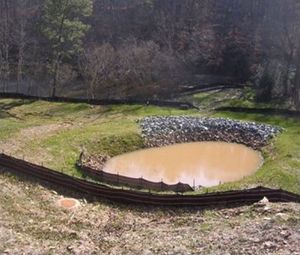
Small sediment trap, click image for more data (Source: Georgia SWCC)
Sediment traps and basins function by intercepting and detaining site runoff, which allows soil particles to settle out prior to discharge. Sediment traps may serve several small catchments on a site, retaining runoff using embankments and other barriers and discharging through an armored overflow or piped outlet to a vegetated swale or other drainage feature. Sediment basins typically serve larger areas than sediment traps and may feature earthen embankments that retain runoff for longer periods of time, releasing runoff via floating, perforated, or slotted risers or floating skimmers that depict clarified water from the surface
Applicability
Sediment traps and basins are very similar in their siting, sizing, and design, with sediment traps serving areas of five acres or less and basins handling larger areas. They represent 1 of the virtually constructive and reliable measures for treating sediment-laden runoff from construction sites. These structures are typically placed almost the perimeter of the site, where flows concentrate in swales , ditches, or other low areas. Sediment traps and basins should be constructed prior to disturbance of upslope areas, if possible, and continue functioning until the contributing drainage area is fully stabilized. Specific considerations related to site applicability and permit applicability are discussed below.
Site applicability
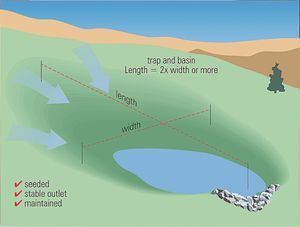
Siting and blueprint considerations for sediment traps/basins, click paradigm for more information (Source: Created by Tetra Tech for U.s. EPA and State of Kentucky)
Disturbed soils on a construction site have the potential to get out the site via stormwater runoff and negatively impact receiving h2o , roadways, and neighboring holding. Sediment traps and basins should intercept concentrated or sheet flows of stormwater discharge from a construction site. Place sediment traps nigh the point of discharge and build traps in series to intercept and treat flow moving downward long drainage paths through a site. Place stormwater basins in low lying areas on the outer edge of a construction site where water naturally flows or is directed co-ordinate to site plans. Sediment traps are particularly useful in perimeter control areas where silt fences volition likely fail. Do not site sediment traps in high-velocity menstruum areas (eastward.g., canal outlets, steep ditches) where excessive turbulence and scour erosion may interfere with sediment settling processes. Neither practice should be placed in surface waters (including intermittent streams) or within their required buffer zones.
Allow applicability
Section xiv (Temporary Sediment Basins) of the MPCA Construction Stormwater General Permit (2018) has several requirements regarding sediment basins, including the following.
- Section 14.ii: Temporary sediment basins are required where 10 (10) or more than acres of disturbed soil bleed to a mutual location. If the acreage of disturbed soil is reduced to less than 10 (10) acres due to establishment of permanent encompass, the temporary bowl is no longer required. Permittees may convert temporary sediment basins to permanent basins after completion of construction.
- Sections xiv.3 and 14.four: For each acre of land that drains to the basin, the basin must provide sufficient alive storage to hold runoff from a 2-year 24-hour tempest event or provide i,800 cubic feet of live storage , whichever is greater. Where permittees accept not calculated the 2 (2)-year, 24-hour storm runoff amount, the temporary basin must provide three,600 cubic feet of live storage per acre of the basins' drainage area.
- Sections 14.5, 14.6, and fourteen.7: Outlet structures must forbid short-circuiting and belch of floating droppings, withdraw water from the surface of the sediment pond, and have sufficient energy dissipation for the outlet within 24 hours after connecting to a surface water.
- Sections xiv.8 and 14.nine: Temporary basins must exist located outside of surface waters and applicative buffer zones. Temporary basins must be constructed prior to disturbance of ten (ten) or more acres of soil draining to a common location.
- Section 14.10 The general construction permit allows other effective sediment controls (eastward.grand., a series of smaller sediment basins and/or sediment traps, silt fences, vegetative buffer strips, etc.) if sediment basin requirements are infeasible to run across on a particular site. This conclusion must be documented in the SWPPP (Stormwater Pollution Prevention Program).
Specific let language
Applicability
- Specifically, section 14.ii of the MPCA Construction Stormwater General Let (2018) states: "Where ten (10) or more acres of disturbed soil bleed to a common location, permittees must provide a temporary sediment basin to provide treatment of the runoff earlier information technology leaves the construction site or enters surface waters. Permittees may convert a temporary sediment basin to a permanent bowl subsequently construction is consummate. The temporary basin is no longer required when permanent cover has reduced the acreage of disturbed soil to less than 10 (10) acres draining to a common location. "
Sizing
- Section 14.3 states: "The temporary basin must provide live storage for a calculated volume of runoff from a 2 (2)-year, 24-hour storm from each acre drained to the basin or ane,800 cubic feet of live storage per acre drained, whichever is greater."
- Section 14.4 states: "Where permittees have not calculated the two (2)-year, 24-hour tempest runoff amount, the temporary basin must provide 3,600 cubic anxiety of live storage per acre of the basins' drainage area".
Outlets
- Section 14.v states: "Permittees must design basin outlets to prevent curt-circuiting and the discharge of floating debris."
- Department 14.half dozen states: "Permittees must design the outlet structure to withdraw water from the surface to minimize the discharge of pollutants. Permittees may temporarily suspend the utilise of a surface withdrawal machinery during frozen weather condition. The bowl must include a stabilized emergency overflow to preclude failure of pond integrity."
- Department 14.vii states: "Permittees must provide energy dissipation for the basin outlet within 24 hours afterward connection to a surface water."
Location and timing
- Section 14.eight states:"Permittees must locate temporary basins exterior of surface waters and any buffer zone required in detail 23.11 of the general permit."
- Section 14.9 states: "Permittees must construct the temporary basins prior to disturbing 10 or more acres of soil draining to a common location."
Alternatives
- Section xiv.10 states: "Where a temporary sediment bowl meeting the requirements of item 14.3 through 14.9 is infeasible, permittees must install effective sediment controls such as smaller sediment basins and/or sediment traps, silt fences, vegetative buffer strips or any appropriate combination of measures as dictated by individual site atmospheric condition. In determining whether installing a sediment basin is infeasible, permittees must consider public condom and may consider factors such equally site soils, slope, and available area on-site. Permittees must document this determination of infeasibility in the SWPPP".
Boosted information on bowl drainage is provided in Construction stormwater treatment - dewatering.
Effectiveness
When designed, installed, and maintained properly, sediment traps and basins have sediment-trapping efficiencies typically between 60 and 80 percent. They need little maintenance compared to other practices that treat sediment-laden runoff, provided upland areas are brought to terminal course and stabilized promptly. Sediment traps and basins provide good control of coarse sediment and are moderately effective for trapping medium-size sediment particles. However, they have a relatively low trapping efficiency for fine silt and clay particles suspended in runoff. Longer detention times, utilize of a flocculant (e.k., floc log contact with upstream incoming flows), or additional sediment command measures may be necessary for removal of finer-textured sediment. In general, the larger the storage book and the longer the detention time of the stormwater, the more than efficient sediment basins are at removing finer particles. Oil, grease, and other floatables may also be removed if using an outlet pipe that features perforated openings, a screen, a skimmer, or other ways to describe ponded h2o from just beneath the surface. Effectiveness in removing floatables is dependent on the outlet design. As a secondary design benefit, sediment traps and basins tin also help control the flow charge per unit and potentially the volume of runoff from a site.
Expected performance for temporary/permanent sediment traps and basins.
Link to this table
| Water quantity | |
|---|---|
| Flow attenuation | Secondary design benefit |
| Runoff volume reduction | Secondary blueprint benefit |
| H2o quality | |
| Erosion prevention | Little or no design benefit |
| Sediment command | Primary design benefit |
| Food loading | Secondary design benefit |
| Pollutant removal | |
| Total suspended solids | Primary design benefit |
| Full phosphorus | Secondary design do good |
| Heavy metals | Secondary blueprint benefit |
| Floatables | Secondary design do good |
| Oil and grease | Secondary design benefit |
Planning Considerations

Where to install sediment traps/basins, click paradigm for more information (Source: Tetra Tech)
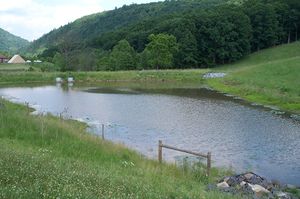
Permanent stormwater basin, click image for more than data (Source: Tetra Tech)
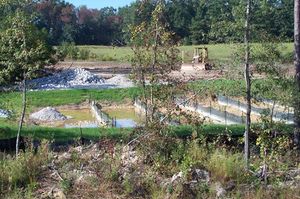
Sediment basin with baffles, click image for more information (Source: Tetra Tech)
Sediment Traps
In order to successfully prevent off-site migration of sediment, sediment traps need to exist properly functioning and in the right location on site. They should be installed early on in the project earlier the site clearing phase begins. The natural drainage of a structure site should be considered prior to planning sediment trap size and location. Locate areas of potential sediment runoff, determine the likely pathway for water draining from those sites, and place sediment traps betwixt the source of sediment and the site perimeter or water body that will receive the runoff. For maximum effectiveness, sediment traps should be placed every bit close as possible to the source of sediment runoff. If the site configuration prevents the use of a single sediment trap, multiple smaller traps arranged in series can be used to meet the design requirement.
Sediment Basins
If sediment traps are non sufficient for stormwater and sediment command, use sediment basins due to their larger capacity. Basins have a larger footprint than sediment traps and should be sited at a depression point on the construction site, where runoff converges. If stormwater does not naturally flow towards the sediment bowl and cannot feasibly be directed to it, a serial of sediment traps or other BMPs may be more than advisable for sediment command. It is recommended that the slopes that carry runoff to the bowl be greater than 1 pct but no more than than 25 percent to promote period towards the bowl. Similar to sediment traps, install sediment basins prior to soil disturbing activities wherever possible. When selecting an area to identify a sediment basin, look for areas that meet the following recommendations.
- Capable of storing sediment and stormwater from as much of the planned disturbed area equally applied
- Provide admission for maintenance throughout the project
- Are far enough abroad (minimum of twenty anxiety of separation) from existing edifice foundations to preserve their integrity
- Where groundwater levels will be lower than the basin bottom
- Limit treatment to runoff from disturbed areas only
- Minimally interfere with the construction site
Temporary sediment basins are often converted to permanent stormwater direction structures once all disturbed contributory drainage areas accept been permanently stabilized and canonical by a stormwater inspection entity and all storm drains accept been flushed. The outlet structure must be installed in accord with an approved stormwater direction pattern plan. Additional grading may be necessary to achieve the required storage book of the bowl. Prior to transition to a post-structure stormwater basin, the bowl must be cleared of accumulated sediment, fully stabilized, and inspected to ensure that side slopes and the volume, containment berm, outlet, and inlets comply with stormwater bowl pattern requirements. Link hither for blueprint data for permanent stormwater ponds.
Design

Typical sediment trap design, click prototype to enlarge (Source: Iowa SUDAS, 2022)
Designs for traps and basins should specify a minimum length to width ratio of 2:1 if possible. The surface area of a sediment trap or basin may range from approximately four to ten percentage or more of the area draining to them, depending on their shape, depth, incoming soil particle size, use of flocculants, and other factors. In general, longer catamenia paths through the trap/basin and greater detention times results in higher rates of sediment removal via settling processes.
Sediment traps
A temporary sediment trap should simply be used in a location with a drainage area of five (5) acres or less and where it will exist used for two years or less.
Sediment traps must accept an outlet to deport runoff from the construction. The outlet can be a pipe outlet, stabilized rock outlet, or other suitable structure. The outlet must exist capable of handling the runoff from a ii-year-frequency, 24-hr-duration storm without failure or significant erosion. Overflow outlets should be stabilized with fibroid aggregate and/or riprap and geotextile fabric. For more information on outlet stabilization, link here.
Sediment trap sizing is dependent on the anticipated drainage area and volume of stormwater to treat. A side slope ratio of 2:1 or flatter is recommended for sediment traps. A minimum length to width ratio of 2:1 should be provided, and the distance between the inlet and outlet should be maximized to increase sediment removal efficiency. Where flow paths are shortened due to tight site conditions, silt fencing can exist used as baffles inside the trap to slow flows through the trap and increase sediment removal.
The case design table beneath provides full general guidance on sizing rectangular sediment traps with sloped sides, based on contributing drainage area. Volumes for sediment traps constructed by installing a rock berm or earthen embankment beyond a swale can be estimated using the triangular pyramid book formula. As a dominion of thumb, a total storage volume of 3,600 ft3 should be provided for every acre of contributing drainage. This volume may be every bit divided between wet (retention) and dry (drawdown, or dewatered) storage. Wet storage is provided in a permanent pool and dry storage provides extended settling time.
Sediment trap sizing tabular array
Link to this tabular array
| Drainage surface area (air-conditioning) | Full Book (ft3) | Wet Volume (ft3) | Dry Volume (ft3) | Minimum Depth (ft) | Depth of Permanent Pool (ft) | Minimum Bottom Length (ft) | Minimum Bottom Width |
|---|---|---|---|---|---|---|---|
| 1 | 3600 | 1800 | 1800 | 2.v | 1.five | 46 | 23 |
| ii | 7200 | 3600 | 3600 | ii.75 | 1.5 | 64 | 32 |
| 3 | 10800 | 5400 | 5400 | 3.0 | 1.75 | 76 | 38 |
Tabular array assumes 2:i side slopes; Minimum depth is from trap lesser to weir crest and includes both wet and dry storage
Embankments are located at the lowest signal of the sediment trap and typically consist of mixed size rock or a stabilized earthen berm with a rock-armored overflow notch. The bottom of the embankment should exist level with the wet storage portion of the trap. The blueprint table below summarizes the recommended embankment top width (also referred to as weir length) for sediment traps as a function of contributing drainage area.
Recommended beach widths for sediment traps
Link to this table
| Contributing Drainage Area (acre) | Beach Width (ft) |
|---|---|
| 1 | 4 |
| 2 | 6 |
| 3 | viii |
| 4 | x |
| 5 | 12 |
Sediment Basins
Per the 2022 MPCA Structure Stormwater General Allow, sediment basins are required when ten (10) or more than acres of disturbed country discharges to a common location. If the site is located within one mile of a special or impaired water , sediment basins are required when five (5) or more than acres of disturbed land discharges to a common location. The maximum drainage area for a single sediment basin should not exceed 100 acres.
Sediment basins consist of a principal spillway, dewatering device, and an emergency (overflow) spillway. A chief spillway conveys the design volume of treated stormwater away from the site and discharges it. It consists of a vertical riser that controls basin water levels and an outlet pipe. A dewatering device releases the runoff over time, allowing the sediment to settle out. Dewatering devices can accept many forms including modifications to risers and floating skimmers. The MPCA Structure Stormwater General Permit (Section 14.vi) requires emergency spillways to safely pass stormwater from storms exceeding the basin design storm without compromising the integrity of the basin.
The full storage volume provided by sediment basins should be a minimum of iii,600 cubic feet per acre of contributing expanse. Contributing drainage surface area should include the unabridged drainage area, non only the disturbed area. The total storage volume should exist divided equally betwixt wet (retention) and dry (drawdown, or dewatered) storage. Storage volume is measured from the lesser of the bowl to the elevation of the main spillway crest.
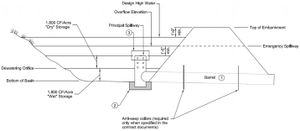
Typical design for a sediment basin with an emergency spillway, click image to enlarge (Source: Iowa SUDAS, 2022)
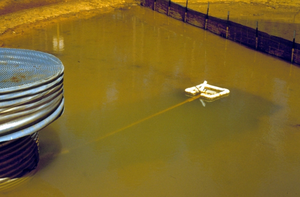
Floating skimmer installed in temporary sediment basin to draw and discharge cleaner water from the top of the impoundment. (Source: J. West. Faircloth & Son, Inc.)
The following design recommendations use to sediment basins:
- The ratio of the surface area (ft2) at the designed high h2o elevation to the belch rate from a 15-twelvemonth, 24-hour storm (cfs) is greater than or equal to 0.0035.
- Basin length to width ratio should be two:1 or greater , in guild to maximize settling fourth dimension.
- Use a wedge design with the inlet located at the narrow end of the basin.
- Locate inflows to the basin equally far from the riser as possible to maximize travel fourth dimension through the bowl and increase effectiveness of handling. Baffles may be installed to maximize detention fourth dimension and increment sediment removal efficiency.
- For pocket-sized temporary sediment traps, the embankment elevation should non exceed five feet. For temporary sediment basins, the beach (dam) height should not exceed fifteen (xv) feet.
- For embankments up to ten (x) feet in acme, the embankment top width should be a minimum of 8 (8) feet. For embankments between ten (ten) and 15 (fifteen) feet in height, the minimum meridian width should exist x (10) feet.
- Soils used for embankments exceeding five anxiety must be selected and compacted in accord with NRCS or MnDOT standards.
- For rock sediment trap berms, use mixed size rock to ensure slower drain-down times and maximum sediment settling.
- Design inside embankment side slopes at a ratio of 2:one or flatter, and outside embankment side slopes 3:1 or flatter. Blueprint all slopes to be stable through the use of erosion controls such as seeding, mulching, and sodding.
- Protect inflows and outlets from erosion by armoring with riprap or other appropriate techniques.
- Increase detention fourth dimension past using stone, filter fabric, rock bags, or similar measures to modify the inlet, and use berms or other approaches that irksome down exiting period to let more sediment to settle.
- Increase sediment removal via flocculation and faster settling through the use of polymers , available as powders, flocculant logs/bags, and other products. Follow manufacturer's directions for applicability and utilize. For more information see Construction stormwater treatment - dewatering, including chemical treatment and sediment filtration.
- For superior sediment basin discharge water quality, consider utilise of a floating skimmer. These devices depict clarified water from the surface of the impounded stormwater, where sediment concentrations are the everyman. Several do-information technology-yourself and proprietary products are available to choose from; see here for more than information.
Construction recommendations and specifications
While sediment traps differ from basins in design options, sizing, and (typically) permanence, at that place are some bones construction recommendations mutual to both BMPs:
- Install traps/basins prior to disturbing large portions of the upland structure site, so they are bachelor for sediment removal during the agile construction menstruation.
- Appraise drainage toward the trap/basin to ensure it conforms to site design. Use berms or ditches to capture flows that may bypass the trap/bowl where necessary.
- Clear and grub the area under the embankment, removing any vegetation and the root mat.
- Ensure that earthen containment berms are constructed according to blueprint. Soils used to construct the embankment must be free of roots, woody debris, big rock, organic fabric, and other non-soil fabric.
- Compact containment embankment make full soils by traversing with equipment in one-foot lifts during construction..
- Ensure that the berm is capable of handling the lateral stress from ponded water (i.e., employ MnDOT and NRCS soil and compaction specifications for embankments exceeding five feet in height).
- For rock sediment trap berms, use mixed size rock to ensure slower drain-down times and maximum sediment settling.
- Outlets (due east.yard., overflow, piped) must be stable and able to handle heavy incoming/approachable flows.
- Ensure there are no big bottom-elevation outlet construction holes, pipe openings, stone voids in the berm, or other features that may cause the trap/bowl to drain down less than 12 to 24 hours afterwards a rain.
- Mixed size stone berms or filter material can exist used, if necessary, to slow flows from permanent stormwater outlets during the construction menses.
- Remove limbs, droppings, trash, building materials, soil stockpiles, etc. immediately later constructing the trap/basin.
- Stabilize side slopes and berms of traps/basins with seed, erosion command blanket, stone, etc. every bit soon as they are built, to prevent filling the bachelor volume with sediment from the trap/basin itself. The bottom can remain unstabilized until last sediment removal occurs.
- Ensure that stormwater discharges from the basin will exit onto an armored anti-scour pad or other erosion proof structure/area, and can move downstream via stabilized swales, ditches, channels, or equally sheet flow.
- Remove whatsoever non-sediment upland materials that may launder into the trap/basin (e.m., limbs, debris, trash, building materials, etc.)
- Stabilize upland areas that may contribute significant amounts of eroded soil to the trap/basin every bit quickly as possible, to avoid frequent dredging and maintenance.
- Utilise silt fencing or other sediment controls where necessary to further reduce sediment inputs to the trap/bowl – it is easier to remove sediment from a silt fence than a trap/basin.
The 2022 MnDOT Standard Specifications for Construction includes several specifications relevant to sediment basins and traps.
- MnDOT Specification 2573.3 Office A includes guidance for construction of temporary sediment basins and traps. Part A.4 (folio 514) states: "Construct temporary sediment basins concurrently with the start of soil disturbing activities. Direct tempest water runoff from drainage areas to the basins. Stabilize the exposed side slopes of the basins. Provide an outlet to the basin that discharges water from the surface, separates floatables, and provides scour protection or free energy dissipation." Part A.six requires the use of a water treatment programme for these devices, stating: "Provide a h2o treatment plan for turbid or sediment laden h2o. Submit the water handling plan to the Engineer earlier pumping. Do not begin piece of work until the Engineer accepts the h2o treatment programme including whatever contractor required permits. Include in the water handling plan the utilise of sediment traps, vegetative filter strips, flocculants, or other water treatments per 3875, 'Water Treatments'."
- MnDOT Specification 2573.3 Office P includes guidance for the maintenance of sediment basins and traps. Part P.2 (folio 518) states: "Drain the basin and remove the sediment when the depth of sediment collected in the basin reaches 50 percent of the storage volume adamant by the outfall device. Consummate drainage and removal within 72 hours or as before long equally field weather condition allow access. Remove sediment to the original designed or excavated class or as necessary to restore the function of the device. Restore stabilized condition of side slopes and admission road. Clean out and shape temporary sedimentation basins intended for employ as permanent water quality management basins every bit shown on the plans." Maintenance is discussed in greater particular beneath.
- MnDOT Specification 2573.4 prescribes "method of measurement" related to temporary sediment traps and basins. Part Due east (Temporary Sediment Traps, page 519) states: "The Engineer will measure sediment trap digging by volume. The Engineer will measure out overflow devices separately." Further, Part G (Sediment Removal) states: "The Engineer volition measure sediment removal from temporary sediment traps and basins by backhoe hours or vac-truck hours. The spreading and hauling of sediment is incidental to the backhoe 60 minutes removal."
- MnDOT Specification 2573.five prescribes "ground of payment" related to temporary sediment traps and basins. Part G (Sediment Traps, page 520) states: "The Department volition pay for removal of sediment from sediment traps past backhoe or vac-truck hour. Sediment spreading and disposal are incidental." Further, Office I (Pay Items, page 521) states that payment past the Department for sediment trap excavation (Item No. 2573.504) shall be calculated on the ground of cubic yards.
- MnDOT Specification 3875 (Water Treatment) outlines requirements for use of passive dewatering handling methods for sediment traps and basins. Specification 3875.ii Part A (page 694) states: "Use passive dewatering treatment methods, using time and gravity to settle out sediments, if draining basins, traps, ditches, or sumps to set up the construction site for the next tempest event." Part A.2 provides specifications regarding the pattern of the riser pipage, stating: "Provide a riser pipe in a pond, basin, or trap outlet structure meeting the following requirements or characteristics.
- Ii-thirds the peak of the outlet above the floor of the structure
- Made of perforated PVC or metal pipe of the same bore equally the outlet structure
- Surrounded past clean rock from ane in to 2 in, for the unabridged pinnacle of the riser pipe.
- Install a trash guard on the top overflow."
The relevant specifications noted in a higher place in 2573.iv (Method of Measurement) and 2573.five (Basis of Payment) are important when because cost implications of these practices, discussed further below.
Inspection and maintenance
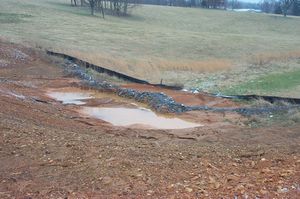
Neglected temporary sediment trap, click image for more information (Source: Tetra Tech)
Sediment traps
The MPCA Construction Stormwater General Permit does not include specific requirements for inspection and maintenance of temporary sediment traps. Temporary sediment traps, all the same, should exist inspected at to the lowest degree weekly and after each 0.five-inch or greater rainfall result and repaired immediately. Recommended maintenance includes the post-obit.
- Ensure that trap sidewalls are vegetated or otherwise stabilized to prevent erosion of the structure and filling of the trap volume.
- Check spillway for accumulated debris, erosion, and displacement of rock.
- Immediately accost erosion, bulging, or other conditions indicating weakness or potential failure of the containment berm.
- Remove sediment from the trap when sediment accumulates to the make clean out level (fifty percent of wet storage depth).
Dispose of dredged sediment at fill areas, soil stockpiles, or other locations where it can exist stabilized with vegetation or independent via sediment controls (due east.chiliad., silt fencing). Dredged sediment containing chancy wastes (i.due east., from sabotage debris, waste matter sites, etc.) must exist characterized and disposed of in accordance with MPCA requirements.
- When performing sediment cleanout, inspect the trap for accumulated trash and other debris. Keep inflow, outflow, and interior of trap clear of any debris.
- Prevent erosion at inflow and outflow by installing and maintaining riprap or other appropriate measures.
- Stabilize or employ silt fencing to address upslope areas that are contributing excessive volumes of sediment to the trap and increasing maintenance needs.
- Maintain original dimensions of trap (grade, depth, etc.) throughout life of do.
Sediment Basins
The recommended maintenance activities outlined in a higher place for sediment traps also utilise to sediment basins. Maintenance of sediment basins is necessary when sediment levels attain half of the design book of the bowl. Once this threshold is reached, 72 hours are allotted for proper maintenance to occur. As noted to a higher place, MnDOT Specification 2573.3 Role P.2 states: "Drain the basin and remove the sediment when the depth of sediment nerveless in the basin reaches fifty percent of the storage book adamant past the outfall device. Complete drainage and removal within 72 hours or as soon as field conditions allow access. Remove sediment to the original designed or excavated grade or every bit necessary to restore the function of the device. Restore stabilized condition of side slopes and access road. Clean out and shape temporary sedimentation basins intended for use equally permanent water quality management basins every bit shown on the plans."
Additionally, during inspections, evaluate the embankment for signs of seepage, settlement, or slumping. Whatever problems should be repaired immediately. All woody vegetation (eastward.g., copse, brush, etc.) should be cleared from the embankment and primary spillway. During sediment cleanout, trash and other debris should be removed from the bowl, dewatering device, and riser construction.
Costs
The following table summarizes estimated BMP costs based on MnDOT information summarizing average bid prices for awarded projects in 2022.
Unit of measurement costs related to sediment traps and basins
Link to this table
| Bid detail | Item clarification | Units | Average toll |
|---|---|---|---|
| 2573602/00010 | Temporary sediment trap | each | $605.00 |
| 2106501/00010 | Excavation – common | cubic yards | $5.lx |
| 2106607/00020 | Digging – subgrade | cubic yards | $9.59 |
| 2106523/00060 | Mutual embankment (CV) | cubic yards | $2.18 |
| 2106521/00070 | Granular embankment (CV) | cubic yards | $eight.51 |
Reference materials
Except where more stringent recommendations are presented in this guidance, BMPs shall comply with MnDOT and other state requirements. Primary design references include:
- 2018 Minnesota NPDES/SDS Construction Stormwater General Permit
- MnDOT Standard Specifications for Construction
- Minnesota Urban Small Sites Best Direction Practise Manual (Chapter 3: Runoff Pollution Prevention – Temporary Sedimentation Basins/Traps)
- MnDOT Erosion Command Handbook II
The following is a list of additional resources that are not specific to Minnesota:
- Make clean H2o Services Erosion Prevention and Sediment Control Manual (2008) (4.iii.9 Sediment Basin and 4.3.11 Sediment Trap)
- Contractor'southward Handbook for Erosion, Sediment, and Stormwater Management on Capital Project Construction Sites (Lexington-Fayette Urban County Government) (2018)
- District of Columbia Erosion and Sediment Control Manual (2017) (Affiliate 6)
- Iowa Statewide Urban Pattern and Specification (SUDAS) Pattern Manual (2016) (Capacity 7E-12 and 7E-13)
- Kentucky Erosion Prevention and Sediment Control Manual (Revised 2009). (Affiliate four.vii)
- New York Country Standards and Specifications for Erosion and Sediment Control (2016)
- Stabilization practices
- Erosion prevention practices
- Erosion prevention practices - temporary seeding and stabilization
- Erosion prevention practices - natural and constructed mulches
- Erosion prevention practices - tackifiers and soil stabilizers
- Erosion prevention practices - erosion control blankets and anchoring devices
- Erosion prevention practices - turf reinforcement mats
- Erosion prevention practices - Riprap
- Sediment control practices
- Sediment control practices - Vehicle tracking BMPs
- Sediment control practices - Perimeter controls for disturbed areas
- Sediment control practices - Check dams (ditch checks, ditch dikes)
- Sediment control practices - Diversion barrier controls (cofferdams/temporary dikes)
- Sediment control practices - Storm drain inlet protection
- Sediment control practices - Outlet energy dissipation
- Sediment control practices - Sediment traps and basins
- Sediment control practices - Stabilized earth/soil berm
- Structure stormwater treatment - dewatering, including chemic treatment and sediment filtration
- Structure stormwater best management practice – buffer zones
- Other practices
- Construction stormwater practices - temporary stream crossing
- Construction stormwater practices - diversion and working in the dry
- Construction stormwater treatment - BMP removal after final stabilization
- Full general principles for erosion prevention and sediment control at structure sites in Minnesota
- Construction stormwater photo gallery
Source: https://stormwater.pca.state.mn.us/index.php?title=Sediment_control_practices_-_Sediment_traps_and_basins
Posted by: morristiver1945.blogspot.com


0 Response to "How To Install A Culvert In A Ditch"
Post a Comment